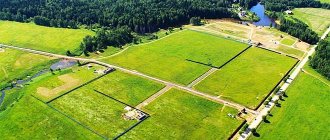Home / Real estate / Land
Back
Published: 11/16/2017
Reading time: 6 min
0
643
The current legislation prohibits the use of land in an illegal manner, since in the event of squatting of the territory and its improper exploitation, significant material damage may be caused to the legal owner of the site.
Unauthorized seizure is an administrative offense that involves bringing the offender to established liability.
- Reasons for illegal seizure of land
- Actions of the owner when a neighbor seizes part of the land When the boundaries are established
- When boundaries are not defined
- Application to the Land Committee
The concept of land squatting
Land is real estate, so you can use and own it after ownership is registered. This is stated in the Land Code. Therefore, until the exact boundaries of the plot are determined, until the right is registered and documents about this are not in the hands of the owner, any actions with the plot are considered illegal.
That is, independent seizure of land is the appropriation of a plot and its use by a person who does not have the right to it. Use occurs to satisfy personal goals, and occupation occurs on one’s own initiative.
This does not mean that ordinary citizens can break the law. As a rule, violators are officials who have access to information about certain plots of land. As soon as it is determined that someone is using the land illegally, this must be recorded in documents. Based on them, the violator will be held accountable. Where to complain when land is squatted? To law enforcement agencies.
Arbitrage practice
Court decisions in cases of illegal occupation of land differ in different situations. Examples from judicial practice:
- A citizen moved a fence on his property, occupying his neighbor's land. The owner of the second plot went to court. A resolution was passed against the invader, according to which he had to vacate the territory, compensate the neighbor’s legal costs and pay a fine of 5 thousand rubles.
- The company expanded the parking lot near the office on its site, occupying territory that does not belong to anyone. A complaint was filed against the organization. During the legal proceedings, the site was declared ownerless and acquired by the company. After registration of property rights, squatting was legalized.
Regardless of the requirements and the specifics of the case, the verdict is made after surveying the areas involved in the trial.
Determination of responsibility for squatting of a land plot
You can use land in Russia on the basis of:
- Ownership;
- Lease agreements;
- Easement;
- Inheritance.
If there are no documents confirming one of these rights, then there is reason to assume that he seized the land on his own. Such actions must be immediately reported to the authorized authorities. Invaders:
- They cannot take any actions in relation to the captured area. They do not have the right to rent it out, sell it, bequeath it or take other actions to alienate the right;
- At the first request of the owner, they must vacate the site. That is, demolish buildings, remove beds, and leave no traces of strangers on the land;
- If the land was used for commercial purposes, then it is necessary to pay its owner a certain amount. It will be equal to the amount of income that was obtained illegally.
Administrative liability rules apply to invaders. It is expressed in the form of a fine, the amount of which depends on whether the plot is registered in the cadastral register and whether its cadastral value has been determined. If yes, then according to Art. 7.1 Code of Administrative Offenses of the Russian Federation, the fine will be:
- for citizens - 1–1.5% of the cost, but not less than 5,000 rubles
- for officials - 1.5–2%, but in any case more than 20,000 rubles;
- for organizations - 2–3%, but not less than 100,000 rubles.
If the cost is not determined, then the fine will be equal to:
- for ordinary citizens - from 5,000 to 10,000 rubles;
- for officials - from 20,000 to 50,000 rubles;
- for organizations - from 100,000 to 200,000 rubles.
What types of violations are associated with public lands?
The law prohibits any restrictions or prohibitions related to access to public areas. Exceptions may be provided only by regulations published for general information. The list of violations of these rules may include:
- seizure of a plot, or part thereof, for use for personal purposes of individuals or enterprises;
- introducing unauthorized restrictions on access to public places - for example, charging a fee for entering a park, if this is not regulated by a municipal act;
- use of a public area contrary to its intended purpose - for example, unauthorized allocation of parking spaces in green areas of squares;
- installation of barriers, barriers, fences to restrict free passage or passage.
These violations may be individual or collective in nature.
For example, a group of residents can equip a parking area by seizing part of an intra-block passage - such a collective violation will entail liability for each of the participants in the unauthorized parking.
The neighbor took over part of the road and installed a garage
Buildings, as everyone knows and understands, must be located on the territory of their owner’s land, and in accordance with the specified standards, observing all the indentations in accordance with fire safety and other standards.
The construction of a garage does not require permission and is not subject to any control, but the garage, nevertheless, must be located within the boundaries of the land plot. But there are cases when the owner built a garage so that part of it faces a road zone, which is a PDO, which is illegal and is a reason to contact Rosreestr.
Illegal installation of a fence in a PDO
The Rosreestr website provides information about the activities of the organization and their fight against crime.
On their website you can find many examples of illegal handling of PDO.
One of them was that in the Orenburg region a man surrounded his plot of land with a fence, capturing part of the road, which made movement along it difficult.
The owner of the site can either pay a fine of 5 to 10 thousand rubles, or receive the right to expand the site in order to avoid demolition of the fence. Such an act is an offense, since according to the Land Code of the Russian Federation, when fencing his land plot, the owner must make a retreat in front of the roadway, otherwise the door/gate should open towards the plot, and not towards the road. It is illegal to move the fence outside the boundaries of the property.
Illegal building
If the position of the garage on the site is not regulated, then non-permanent outbuildings and permanent buildings are subject to rules for their location on the site; building a house generally requires a building permit.
That is why a building outside a site that is not in personal ownership, but on a PDO, is a significant offense. Therefore, when a neighbor decides to build a shed in the middle of the road, this is a reason to ask for an inspection.
The road is blocked, there is no access to the land plot
The road and the approach to the house are a public area; blocking the path along it with anything - a garage, a fence, a doghouse or a shed - is illegal.
Self-occupation of residential premises and a plot of common property
Before considering such an example, let's familiarize ourselves with the concept of common ownership. This issue is already regulated by the Housing Code of the Russian Federation, Articles 37 and 162.
According to the Housing Code of the Russian Federation, common property is such common areas (including property) that belong to the owners of the premises of an apartment building, provided that the share of common property is proportional to the area of the owner’s apartment, and also provided that the allocation and abandonment of these shares is prohibited in law.
As for the composition of common property, it includes:
- premises in an apartment building that are not parts of apartments and are intended to serve more than one residential and (or) non-residential premises in this apartment building;
- roof areas;
- enclosing non-load-bearing and load-bearing structures of an apartment building;
- a plot of land on which an apartment building is located and the boundaries of which are determined on the basis of state cadastral registration data, with elements of landscaping and landscaping;
So, as for the example, in practice it often happens when one of the residents seizes common property in an apartment building.
For example, a neighbor arbitrarily seized a stroller and, having installed a wall, included it in the area of his apartment. This happened without collecting signatures from neighbors, and without obtaining permission. This happens often, in most cases with impunity.
How to legalize the squatting of a land plot: step-by-step instructions
How to legalize the squatting of a land plot? The law provides for the registration of ownership of squatted land. But to do this, you need to follow the instructions that will help you register your right correctly, without violating the law. These are the following steps:
- you need to find out who has the legal right to this plot;
- then you need to carry out land surveying, re-establish the boundaries of the site, and obtain a new cadastral passport;
- Based on the documents received, it is already possible to register a legal right.
Step one: establish the copyright holder
How to register land squatting? In order to obtain information about the owner of a specific plot, it is necessary to make an official request to government agencies that may have the information. This:
- to Rosreestr;
- to the local administration in the architectural or land department.
After some time, an official response will be received about the owner of the site. If it belongs to local authorities or a garden (dacha) partnership, then it is necessary to write an application for the allocation of this plot for use by a specific person.
In order to obtain the right of use from the state, it will be necessary to win an auction. If the site is privately owned, then it is necessary to enter into negotiations regarding the alienation of ownership rights.
When holding an auction, there is a real opportunity to slightly increase the area of land, and to carry out the registration of occupation of public territory quite quickly and quite cheaply - only 15% of the cadastral value per sq. m.
If there is no information about who is the legal owner of this plot, then you need to contact local authorities and submit a request for them to put the land on the cadastre. Only after a year has passed from the date of registration, the land will become the property of the municipality. Only now can you apply for the right to use.
In order to obtain the right to use, you must write an application and attach to it:
- geodesy plan;
- BTI plan;
- deed of ownership of the plot;
- cadastral passport.
If the answer is positive, then the user has the right to buy it from the municipality.
Step two: we carry out border surveying and receive a new cadastral passport
Land surveying is an integral part of registering ownership of a plot of land. This event is not cheap, but it must be carried out in order to legally mark the boundaries of the allotment. This event will allow negotiations with neighbors regarding borders in the world order.
You need to contact a geodetic company so that a specialist can come with documents, set boundaries and secure the boundaries. Now you can issue a new cadastral passport. To do this, you need to prepare the following documents:
- your passport;
- documents for the plot, which will confirm that the applicant has the right to use the land;
- boundary and geodetic plans;
- application for a new passport;
- document confirming that the applicant has paid the fee.
If there are no problems, the passport will be ready 20 days after submitting the application. If there are comments, they will be documented in writing, and the registrar will give a deadline for their elimination.
Final stage: registration of rights
How to register land squatting? Once the new cadastral passport is in the hands of the applicant, he can submit documents for registration of property rights. To do this, you need to contact the Rosreestr office at the location of the site. The appeal takes place through the MFC. To do this, you need to prepare the following documents:
- the statement itself;
- applicant's passport;
- new cadastral passport;
- the agreement on the basis of which the applicant acquired the right to use the land;
- a receipt confirming that the applicant has paid the fee for registering the right.
When the documents are accepted, the applicant will be given a paper that will indicate the date of receipt of the extract on registration of the right. If there are unauthorized buildings on the site, then after obtaining the right to the land, it is necessary to obtain the right to each of them. To do this, you need to prepare all the above documents, plus documents for each building, and a receipt for payment of the fee.
What to do when seizing land
In a situation where the site is illegally occupied by other persons, the owner is recommended to take a number of consistent actions aimed at returning his rights and compensation for damage:
- try to resolve the situation peacefully. In some cases, the violator of land boundaries may simply not be aware that someone’s rights are being violated. For example, when areas have no visible landmarks. In such cases, there is a high chance of solving the problem without going to court or turning to other authorities;
- prepare an official claim demanding the release of the occupied plot, indicating the actual boundaries of the land;
- record the fact of violation. Depending on the situation, this may be Rosprirodnadzor or Rosreestr;
- prepare an application to the court;
- submit an application and take part in the trial.
After the judicial act is issued, all that remains is to wait for it to come into force. Then you need to obtain a writ of execution and contact the bailiff service, who will assist in the enforcement of the decision.
If the boundaries of the site were not previously determined or points were not removed from the area, it is recommended to do this before going to court. Otherwise, it will be more difficult to prove your position.
If stopping the violation (unauthorized occupation of the plot) is impossible, the court may decide to buy it out. The price is calculated in this case according to market indicators prevailing in the region.
Compensation for harm for unauthorized occupation
Compensation for damage for unauthorized occupation of land is made only in civil law.
The owner can file a claim for damages immediately with the claim to vacate the territory or separately. In each case, you need to correctly calculate the amount of the claim.
Damage may include not only direct losses, but also lost profits. However, it is more difficult to calculate and prove. It is necessary to collect documentary evidence that the profit was not received precisely because the plot was illegally seized, as well as the fact that under other circumstances there were all the factors for obtaining it, for example, there is a grain supply agreement, but due to the impossibility his cultivation agreement was not fulfilled.
Collection of funds is carried out through the court. If after this the debtor does not give up the land and does not compensate for the damage voluntarily, it is necessary to contact the bailiff service to begin the forced collection procedure.
Forced seizure
A plot that was illegally seized will still be confiscated from the person who seized it. At the same time, his voluntary release will avoid not only the participation of bailiffs in the case, but also additional costs.
To exercise their powers, FSSP employees can involve third-party specialists, for example, Rosreestr employees to determine local boundaries. The violator will first be asked to voluntarily vacate the territory, and then forced action will follow.
Grounds for refusal of state registration
Submitting documents for registration of a right does not mean that it will necessarily be registered. The applicant may be refused, in some cases. The reasons for this are as follows:
- documents are not prepared in accordance with current legislation;
- this land plot is the subject of legal proceedings regarding the establishment of legal boundaries;
- the register does not contain updated information about the boundaries of this land plot;
- there is a conflict between the already registered right and the one they are trying to register now;
- the completed documents do not contain all information about the applicant or the site, or the information provided is not true.
In order to register ownership of a plot of land that fits the category of squatting, you must contact a qualified specialist in St. Petersburg for legal services. Do not delay in submitting documents, as illegal use may lead to penalties.
Captures and development of forest lands
In some cases, illegal owners are simply expelled from the occupied territory, obliging them to pay fines. Others are a little more lucky. Spontaneous expansion of the boundaries of one’s territory can be different.
- In some cases, active land owners have been developing the adjacent abandoned territory for several years. They can expand quite a bit. There are options for friendship with neighbors.
- Some people give away part of their plot out of the kindness of their hearts or in exchange for something. After several years and a change of owners, disputes arise in these areas due to inconsistencies with the documents.
- There is a third option. People simply fence off an abandoned plot. They develop it and erect buildings.
The first two cases fall under the definition of adding land to one’s own plot.











